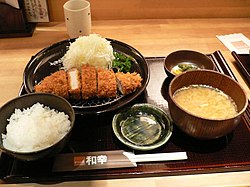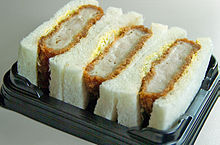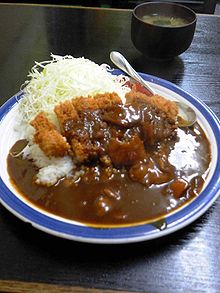Tonkatsu
This article needs additional citations for verification. (September 2009) |
 Tonkatsu served with shredded cabbage, boiled rice and miso soup | |
| Place of origin | Japan |
|---|---|
| Main ingredients | cutlet (pork fillet or loin), cabbage, miso soup |

Tonkatsu (豚カツ, とんかつ or トンカツ, pork cutlet), is a Japanese food which consists of a breaded, deep-fried pork cutlet. There are two main types, fillet and loin. It is often served with shredded cabbage.
Tonkatsu originated in Japan in the 19th century. As well as being served as a single dish, it is also used as a sandwich filling or in combination with curry.
Preparation and serving
Either a pork fillet (ヒレ, hire) or pork loin (ロース, rōsu) cut may be used; the meat is usually salted, peppered, dredged lightly in flour, dipped into beaten egg and then coated with panko (bread crumbs) before being deep fried.[1]
Tonkatsu is generally served with shredded cabbage.[2] It is most commonly eaten with a type of thick Worcestershire sauce called tonkatsu sauce or simply sōsu (sauce), karashi (mustard) and perhaps a slice of lemon. It is usually served with rice, miso soup and tsukemono and eaten with chopsticks. It may also be served with ponzu and grated daikon instead of tonkatsu sauce.
History
Early katsuretsu was usually beef; the pork version was invented in Japan in 1899 at a restaurant called Rengatei in Tokyo.[3][4][5] It was originally considered a type of yōshoku—Japanese versions of European cuisine invented in the late 19th and early 20th centuries—and was called katsuretsu (cutlet) or simply katsu.[6] The term "tonkatsu" (pork katsu) was coined in the 1930s.[citation needed]
Variations


Tonkatsu is also popular as a sandwich filling (katsu sando) or served on Japanese curry (katsu karē). Tonkatsu is sometimes served with egg on a big bowl of rice as katsudon.
In Nagoya and surrounding areas, miso katsu, tonkatsu eaten with a Hatchomiso-based sauce, is a specialty.[7]
Variations on tonkatsu may be made by sandwiching an ingredient such as cheese or shiso leaf between the meat, and then breading and frying. For the calorie conscious, konnyaku is sometimes sandwiched in the meat.[citation needed]
Several variations of tonkatsu use alternatives to pork:
- Chicken katsu (チキンカツ), which uses chicken instead, often appears in Hawaiian plate lunches.
- Menchi-katsu (メンチカツ) or Minchi Katsu (ミンチカツ mince Katsu), is a minced meat patty, breaded and deep fried.
- Hamu katsu (ハムカツ ham katsu), a similar dish made from ham, is usually considered a budget alternative to tonkatsu.
- Gyū katsu (牛カツ beef katsu), also known as bīfu katsu, is popular in the Kansai region around Osaka and Kobe.
Saengseonkkaseu (생선가스 fish katsu) is a Korean fish cutlet modeled on the Japanese dish. Tonkatsu in Korea is known as donkkaseu (돈까스) or donkaseu (돈가스), a simple transliteration of the Japanese word to Korean.[8]
A similar cuisine with ingredients other than pork, beef or chicken is called furai (fry), not katsu (cutlet), such as aji-furai (fried horse mackerel) and ebi-furai (fried prawn).[9]
See also
References
- ^ Tsuji, Shizuo; Fisher, M.F.K. (2007). Japanese Cooking: A Simple Art. Kodansha International. p. 240. ISBN 4-7700-3049-5.
- ^ Hosking, Richard (1995). A Dictionary of Japanese Food: Ingredients and Culture. Tuttle. p. 159. ISBN 0-8048-2042-2.
- ^ 岡田, 哲. とんかつの誕生―明治洋食事始め. p. 166.
- ^ 小菅, 桂子. にっぽん洋食物語大全. p. 122.
- ^ Kaneko, Amy (2007). Let's Cook Japanese Food!: Everyday Recipes for Home Cooking. Chronicle Books. p. 101. ISBN 0-8118-4832-9.
- ^ Jennifer Ellen Robertson, ed. (2005). A companion to the anthropology of Japan. Wiley-Blackwell. p. 421. ISBN 0-631-22955-8.
- ^ http://www.nic-nagoya.or.jp/en/e/archives/629
- ^ Bae Su-gang (배수강) (November 30, 2004). "국립국어연구원, 다듬은 말 바로쓰기운동 펼쳐 The National Institute of the Korean Language, started a campaign to use refined (loan) words" (in Korean). Eorinni Dong-a (Kids Dong-a).
'돈가스'도 마찬가지. 돼지를 뜻하는 일본어 '돈'과 고기를 다진 후 빵가루를 묻혀 기름에 튀긴 '커틀릿(cutlet)'의 일본식 발음인 '가스'가 합쳐져 잘못 사용되는 말로.. 생선가스..도 각각 '생선튀김'.....로 바꿔야 한다. Translation: "Dongaseu is the same as well. It is a misused term that derives from the combination of the Japanese term ton, meaning pork, and the Japanese pronunciation of 'cutlet', made by frying minced and breaded meat... Saengseonkkaseu should also be changed to saengseon twigim (fried fish)."
- ^ "Katsu" (in Japanese). Dictionary of etymology.
Difference between katsu and furai is not defined explicitly; however, cuisine made of fish or vegetables are not called katsu but called furai.
